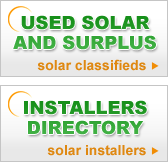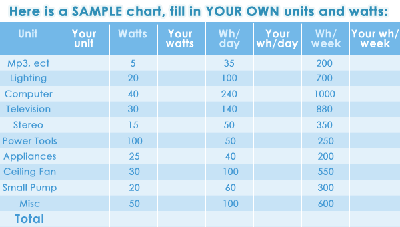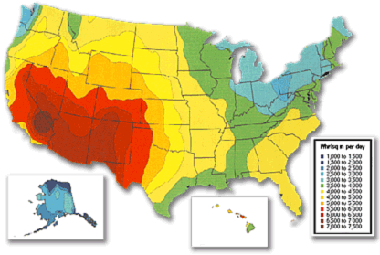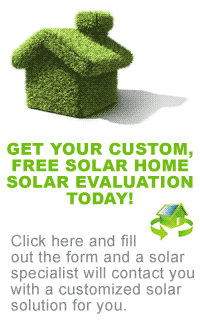|
B. Determine Battery Bank Size C. Determine Solar availability First we’ll need to tabulate your solar energy load, and then we’ll have to optimize that energy load. This means making your PV energy load as efficient as possible. Cost savings can be substantial. It is much easier to optimize/reduce your energy load (for instance by purchasing more efficient appliances), than to increase the size of your PV system – to power an inefficient load. There are numerous energy efficient products available. (for example, upgrading to a hi-efficiency or propane refrigerator may be a better buy than buying more PV panels + batteries to power your old fridge). Check out various appliances on www.solarhome.org . The first step will be to determine your PV energy usage. Which electrical loads do you want to run off your PV system? Make a list and record the wattage of each unit (appliance, stereo, computer, entertainment item, etc.) Each unit and appliance has a nameplate on it that tells you how many watts it needs. You could also look up the units’ model# on the web, look at a specification sheet, or ask an appliance dealer/manufacturer to get the wattage rating. First make a table (Figure 3) of your daily and weekly energy needs, by multiplying the unit’s watts X the average # hours per day and then X the average days per week that you use it. Wh (Watt hours) / day = Watts X average hours/day use
Figure 3: Energy load chart
If you will do net metering (selling your electricity to your utility company), then you can skip this section. If you are going to be independent of the utility company, you will need to install batteries to power your electrical loads at night and on cloudy days. Determining your electrical storage needs requires that you assess your nighttime energy usage and how many days without sunshine (cloudy days) you want your electrical loads to operate. Many people allow for 4-6 nighttime hours and 2-4 cloudy days. Anything higher than this will add substantially to your battery size and cost.
Temperature: Keep in mind is that batteries are sensitive to temperatures – hot and cold. Try to keep you batteries in a relatively warm and dry location. Solar charge controllers usually have temperature compensation built into them. Mix and match: Don’t! It is important to purchase and install the same type batteries all at one time. Mixing different battery types, sizes and especially different ages (states of discharge) will cause more problems than it is worth, as the battery bank will seek the state of its weakest link. Type of battery: Only deep discharge batteries should be used on a stand-alone solar system. Some people use RV or marina type batteries, but you’re better off with industrial grade deep-discharge batteries for longer life.There are many different types of batteries. Contact your local battery distributor or the web for a review of these. Amp-hours: All batteries have some # amp hour rating. A battery rated at 100
amp hours (20 hour reference) will deliver 5 amp hours for 20 hours
before being discharged. The higher the amp hour rating, generally
the more expensive, heavier and longer the battery will hold a charge. From your Energy Load Chart (see Figure 3 example) multiply your Amp Hours per Day times the number of cloudy days that you want your system to provide continual power for. Divide this by how deep you want to discharge your batteries (no more than 70%) and that is the amp hour rating of the batteries you’ll need: AmpHours/Day X # Cloudy Days / 0.70+ = Amp Hour rating of Batteries In our example from Figure 3 of 42 AmpHours/day, if we want to store energy for 3 cloudy days and not have our batteries go below 70% discharge; we would need 180 AmpHours of battery power [ (42 X 3) / 0.7 = 180 ]. If we were going to operate these batteries around 40-50 F continually, we would add another 20% capacity (216 AH). Now you can buy one battery rated at 180 AH, or you can buy several batteries (for instance 3 @ 60 AH) and wire them in parallel. Battery Voltage: Most solar PV system batteries use a combination of 6 or 12 VDC batteries. Sometimes these batteries are wired in series to provide 24 or 48VDC power for hi-power PV arrays. Sometimes these batteries are wired in parallel to provide more amp-hours at the same voltage. Solar system batteries are usually heavy, contain heavy metal toxins, can be costly to transport, and local servicing and exchange may be needed. It is usually a good practice to stay local with batteries. You’ll probably find an industrial forklift or golf-cart type battery distributor in your locale that will work for your solar PV system battery needs. The workhorse of the solar PV industry is the Trojan L-16. It has been used on thousands of solar systems since the 1980’s and has stood the test of time regarding cost, maintenance, and end-of-life replacements. They can last anywhere from 5-15+ years depending on how you monitor and take care of them. There are some basics to follow if you want to extend the life of your batteries:
In order to size your solar system properly, you need to figure out how much sun (solar radiation) you have available. Be sure your site has good exposure to an unobstructed and open sky. Remember that solar angles change considerably between summer and winter. All solar installations are optimized for winter and some for spring/fall solar angles. If your home’s ‘solar view’ is shaded by trees, adjacent structures, or other obstructions, especially at the south/south-west; you may need to move – just kidding! There are three ways to determine solar availability:1. The easiest and least accurate way is to walk around your property and look for the best solar view –pretend you’re a solar collector and you need sun - look for the maximum amount of open sky you have available throughout the typical day. 2. The next best way (our recommendation) is to get solar radiation data from good web sources:
If you’re in the blue area of Figure 4, you’ll need a lot more solar panels than if you are in the dark yellow or red areas.
3. Buy a solar angle calculator and learn how to use it properly. It basically consists of a transparent sun tracker for your specific latitude that you position where your PV panels will be located. You can estimate or mathematically calculate the amount of solar radiation available for each month of the year at your specific location. This is very time consuming, and not for the timid. ________________________________________________
 |















